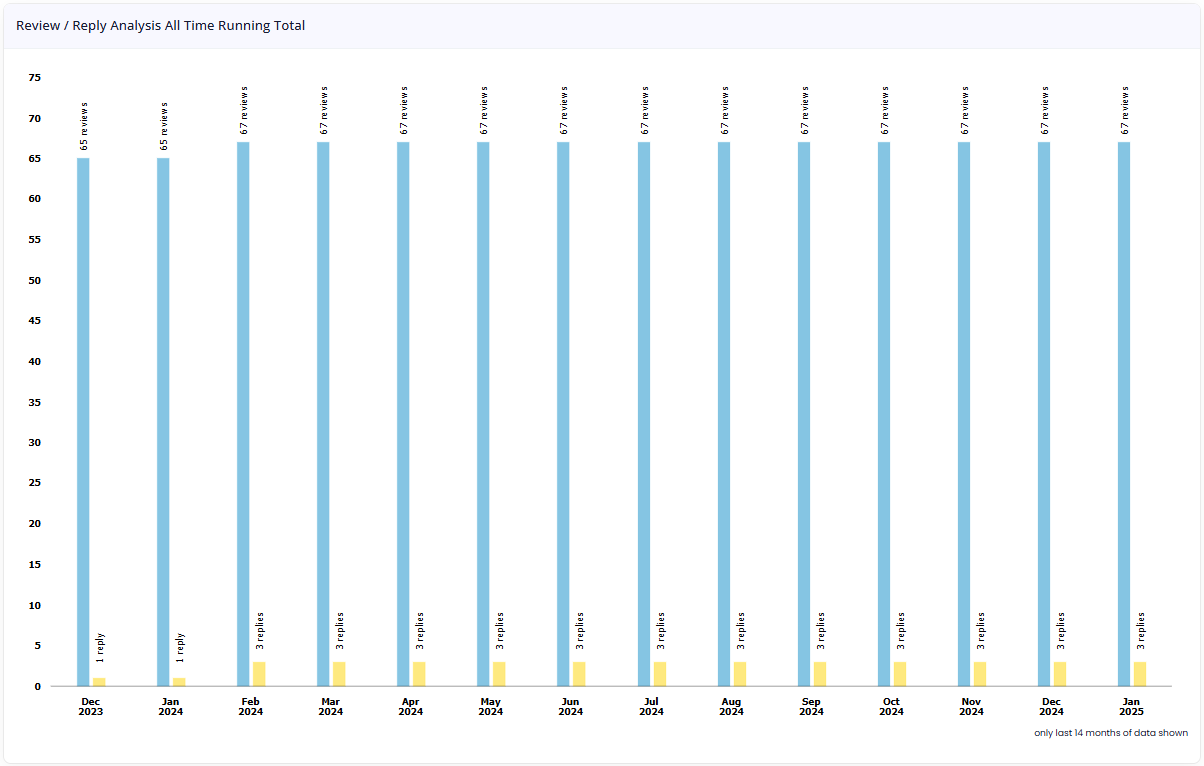The Review Insights section is your platform for viewing and evaluating your setting’s reviews over time to help you identify where to concentrate your efforts to maximise the number of enquiries generated.
You can find the Review Insights section under 'Reviews' in your Control Panel. Click on 'Review Insights' and a drop down menu will appear. Here, you can access Review Score Analysis, Review / Reply Analysis, Review Rating Analysis, Review Source Analysis, Review Word Cloud and Reviews Analysis CSV Export.
The graphs and charts under each section enable you to identify what parents and guardians appreciate most about your nursery, such as the management, staff or the care and support received.
Review/Reply Analysis
The Review/Reply Analysis allows you to view how many reviews your nursery has received over time, and how many reviews you have replied to.
- You can view the all-time number of reviews/replies

At the bottom of the page, you can export the data as a CSV or PDF file.
Review Score Analysis
Each setting can reach a maximum review score of 10. The Review Score Analysis section breaks down the points gained from reviews totalling your review score.

Review Rating Analysis
In this section, you can view the all-time average ratings of your setting. More importantly, at the bottom of the page, you can view a breakdown of your average rating.

The table shows how parents and guardians have rated each of the 12 individual components of their review, such as overall standard, learning, cleanliness and value for money.
Having recent reviews is an important factor in how the review score is calculated.
a) The 5 points available for the average rating is based on reviews in the last 24 months (previously over all time). If your reviews in the last 24 months had a higher average rating than your reviews over all time this will have had a positive effect on your review score, and vice versa.
b) The 5 points available for the number of positive reviews is now based on:
- 4 points are available for 10 Positive Reviews in the last 24 months (previously 5 reviews). If you have less than 10 reviews this will have a had a negative effect on your review score.
- 1 point is available for reaching a number of Positive Reviews based on 20% of the number of registered child places in the last 24 months (same as before)
For more information on how the review score is calculated, click here.
Review Source Analysis
The Review Source Analysis tells you how your setting’s reviews have been submitted, such as Postal Card, Invite to Review and Website Review.

Review Word Cloud
The Review Word Cloud shows the most used words used by reviewers, including a table with the number of occurrences.

Review Analysis CSV Export
In this section, you can choose from a range of datasets and export to a CSV for use in software such as Microsoft Excel.
Examples include All Time Average Rating, Rank in Region by Review Score and Rank in District by Review Score.
Identifying how to improve review score and ranking
Datasets particularly useful to help you identify how to improve review score and ranking are:
- Review score
- Number of reviews published
- Rank by default
- Rank by subscription level
- Reviews published on a monthly basis
- Review score on a monthly basis
Exporting these datasets allows you to identify how your setting's review score and ranking has increased or decreased in relation to reviews published and subscription level.
The review score is partly calculated using reviews published in the last 24 months:
- 4 points available for 10 positive reviews in the last 24 months
- 1 point is available for the number of positive reviews reaching 20 per cent of the registered maximum number of childcare places in the last 24 months.
If your review score has gone down, you can use the Points from Positive Reviews Published in the last 24 months to identify whether it is time to generate new reviews in order to get the maximum 5/5 points for reviews published in the last 24 months to improve your total Review Score.
For example:
Groups can utilise the datasets to view their settings’ current performance and see where improvements can be to increase Review Score and ranking, both for individual nurseries and the group itself.
Using the following datasets allows you to get an overview and determine where you should focus your efforts to achieve the maximum of 5 points for reviews published in the last 24 months, improving your overall Review Score.
- Review Score
- Positive Reviews Published in the last 24 months
- Positive Reviews Required for Max Score
- Additional Positive Reviews Required for Max Score
- Latest Published Review
This could look something like this, with an added traffic light system to the data for better readability:

The settings highlighted in green have achieved the requisite amount of reviews over the previous 24 months.
However, the settings highlighted in orange still need more positive reviews to be able to achieve maximum score. They are achieving some reviews but would grow their score by focusing on generating additional reviews.
Additionally, the setting in red needs 7 positive reviews to achieve maximum score for reviews published in the last 24 months.
The data tells us that putting more effort into inviting to review for the settings highlighted orange and red and receiving positive reviews will enable them to achieve the maximum Review Score, and in turn increase the overall Group Score.
It is important to also note that a high volume of reviews makes the feedback more trustworthy to parents. More reviews mean more enquiries – the top 100 profiles on daynurseries.co.uk have on average 5 more reviews than the site average.
To find out more about what the top 100 performing profiles look like, click here.